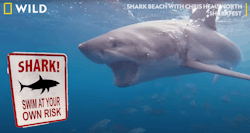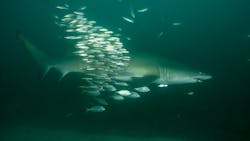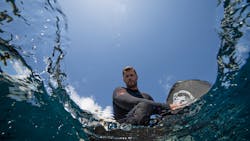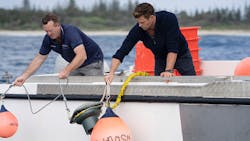Diving into the World of Sharks and Attack-Prevention Tech
Sharks come in all sizes, from the dwarf lantern shark (Etmopterus perryi) to the massive great white (Fig. 1). They are fascinating creatures that must continually move to stay alive as movement is the only way to move water through their gills to provide them with oxygen. Sharks are critical to the ocean ecology, but, as with many marine lifeforms, they’re being stressed by pollution, global warming, and man.
While most sharks are small or inoffensive, larger critters can cause harm to people. The movie Jaws takes things to extremes, but people have been killed by sharks. Such attacks have become more frequent as oceans adjust to global warming and people become more numerous in areas where sharks have been living for millennia, like the east coast of Australia.
Shark Beach with Chris Hemsworth is a new National Geographic film about sharks hosted by actor Chris Hemsworth, of course (Fig. 2). Chris is an avid surfer and is interested in shark ecology. I enjoyed watching the film and picked up on a few technology-related items that I will mention here.
A significant portion of the film relates to larger sharks like the great white and the danger they pose to people, as well as the issues related to the sharks themselves. For example, massive shark nets have been deployed along the coast near beaches frequented by people, and there’s a lot of them. Unfortunately, these shark nets aren’t that effective—sharks can swim around or under them and the nets also snag other marine life that will not attack man. Eventually, these animals succumb once trapped in the nets.
Another tactic is called a drumline. These are buoys with a hook, line, and sinker tipped with a fish that the shark would eat, causing them to become hooked. The shark dies horribly, but it prevents that shark from coming close to a person. In most cases this would not happen anyway, though thousands die to prevent one human catastrophe.
The Smart Drumline Program uses the same approach. However, instead of letting the shark die, the buoy contains a radio transmitter—it alerts a nearby boat that can then catch, tag, and release the shark (Fig. 3). They can also notify any nearby surfers and beachgoers, which is typical when a shark is sited by other means. Tagging also provides information about shark movements, enhancing our understanding of these creatures.
Personal shark protection is something a number of companies and organizations are involved with, and it’s examined within the movie. Professor Huveneers leads the Southern Shark Ecology Group within the Marine & Coastal Research Consortium at Flinders University in Adelaide, South Australia. They are evaluating various techniques and products that repel sharks. Most center around electrical fields (Fig. 4).
For more on this research, check out the The Technology Behind Shark Beach video interview I did with Professor Huveneers discussing the technology and movie.
Essentially, sharks have a very sensitive front end. This generally turns out to be a big advantage for the shark, unless a human has a device that can generate a field affecting that sensitivity. The approach is not 100% effective but significant enough that it could greatly reduce bad shark/person interactions.
Some products are commercially available and used in devices, such as Ocean Guardian’s surfboards (Fig. 5). Furthermore, systems are being worked on that can be used to deter sharks from large areas, such as around ships or beaches.
About the Author
William G. Wong
Senior Content Director - Electronic Design and Microwaves & RF
I am Editor of Electronic Design focusing on embedded, software, and systems. As Senior Content Director, I also manage Microwaves & RF and I work with a great team of editors to provide engineers, programmers, developers and technical managers with interesting and useful articles and videos on a regular basis. Check out our free newsletters to see the latest content.
You can send press releases for new products for possible coverage on the website. I am also interested in receiving contributed articles for publishing on our website. Use our template and send to me along with a signed release form.
Check out my blog, AltEmbedded on Electronic Design, as well as his latest articles on this site that are listed below.
You can visit my social media via these links:
- AltEmbedded on Electronic Design
- Bill Wong on Facebook
- @AltEmbedded on Twitter
- Bill Wong on LinkedIn
I earned a Bachelor of Electrical Engineering at the Georgia Institute of Technology and a Masters in Computer Science from Rutgers University. I still do a bit of programming using everything from C and C++ to Rust and Ada/SPARK. I do a bit of PHP programming for Drupal websites. I have posted a few Drupal modules.
I still get a hand on software and electronic hardware. Some of this can be found on our Kit Close-Up video series. You can also see me on many of our TechXchange Talk videos. I am interested in a range of projects from robotics to artificial intelligence.






